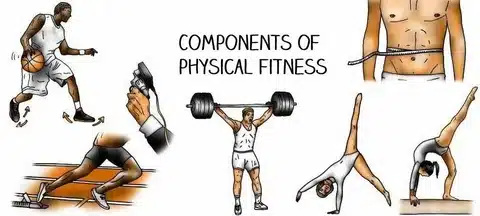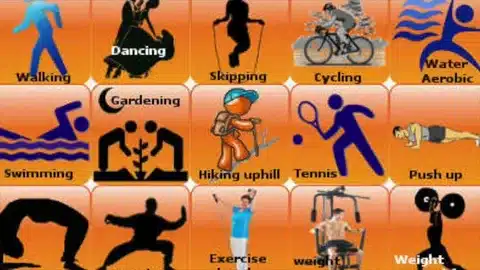Introduction
Physical fitness is a multifaceted concept that encompasses various aspects of health and well-being, and it plays a pivotal role in maintaining an active and fulfilling lifestyle. To comprehensively understand and assess one’s physical fitness, experts have identified 12 key components that collectively contribute to a person’s overall physical well-being. These components go beyond just strength and endurance, encompassing factors such as flexibility, balance, and body composition.
In this exploration, we will delve into each of these 12 components of physical fitness, shedding light on their significance and the role they play in achieving a well-rounded and healthy body. Understanding these components is essential for anyone striving to optimize their physical health and performance, whether for athletic pursuits or simply to lead a more active and vibrant life.Physical fitness is a multifaceted concept that encompasses various aspects of health and well-being, and it plays a pivotal role in maintaining an active and fulfilling lifestyle.
To comprehensively understand and assess one’s physical fitness, experts have identified 12 key components that collectively contribute to a person’s overall physical well-being. These components go beyond just strength and endurance, encompassing factors such as flexibility, balance, and body composition. In this exploration, we will delve into each of these 12 components of physical fitness, shedding light on their significance and the role they play in achieving a well-rounded and healthy body.

What are the 10 components of fitness in order?
They are cardiovascular respiratory endurance, stamina, strength, flexibility, power, coordination, agility, balance, and accuracy. You are as fit as you are competent in each of these 10 skills, and a regimen develops fitness to the extent that it improves each of these 10 skills.
Cardiovascular Endurance: This refers to the ability of the heart and lungs to supply oxygen to the muscles during prolonged physical activity.
Muscular Strength: It is the maximum force a muscle or group of muscles can generate during a single contraction or lift.
Muscular Endurance: This component relates to the ability of muscles to perform repetitive contractions or sustain a contraction over an extended period.
Flexibility: Flexibility is the range of motion of your joints and muscles. It allows you to move your body freely and perform daily activities with ease.
Body Composition: Body composition measures the relative proportions of fat and nonfat mass in your body. It’s an indicator of overall health and fitness.
Speed: Speed is the ability to move quickly from one point to another in a straight line.
Power: Power is the combination of strength and speed and represents how quickly you can exert force.
Agility: Agility is the ability to change direction or body position quickly and efficiently while maintaining control and balance.
Balance: Balance involves the ability to control your body’s position, whether it’s stationary or moving, and avoid falling.
Coordination: Coordination is the ability to use different parts of the body together smoothly and efficiently to perform tasks effectively.
What does Fitt stand for?
FITT (frequency, intensity, time, and type) is one way to remember the general guidelines for what should be included in a fitness plan. Remember, it’s important to keep in mind that each family member’s fitness goals will be different based on age, sex, current fitness level, and available resources.
FIT(T) is an acronym commonly used to help individuals remember the key principles of designing an effective exercise program.
Frequency: This refers to how often you exercise. It’s important to establish a regular workout schedule that suits your goals and fitness level. For example, you might aim to exercise three to five times a week.
Intensity: Intensity relates to how hard you work during your exercise sessions. It can be measured in various ways, such as heart rate, resistance level, or perceived exertion. Adjusting the intensity allows you to challenge yourself and make progress.
Time (or Duration): Time refers to the length of your exercise sessions. Depending on your fitness goals, workouts can vary in duration. For example, cardio workouts might range from 20 minutes to an hour or more, while strength training sessions can vary in length depending on the exercises and sets performed.
Type: Type indicates the specific mode or type of exercise you choose. It can include cardiovascular activities (e.g., running, cycling), strength training (e.g., weightlifting), flexibility exercises (e.g., stretching), or a combination of these based on your fitness goals and preferences.
What are skill components?
Skill-related fitness is broken down into six different components; agility, speed, power, balance, coordination, reaction time.
Agility: Agility is the ability to change direction quickly and accurately while maintaining balance and control. It’s crucial in sports like soccer, basketball, and tennis, where rapid changes in direction are required.
Balance: Balance is the ability to maintain equilibrium while stationary or moving. Good balance is essential for activities such as yoga, gymnastics, and even everyday tasks like walking and standing on one leg.
Coordination: Coordination refers to the ability to use different body parts or senses together harmoniously to perform complex movements. It’s vital in sports like dancing, martial arts, and many team sports where precise timing and movement synchronization are essential.
Power: Power is the combination of strength and speed. It’s the ability to exert force rapidly, making it essential for sports like weightlifting, sprinting, and jumping events.
Reaction Time: Reaction time is the ability to respond quickly to a stimulus, such as a visual cue or a sound. It’s critical in sports like boxing, table tennis, and baseball, where rapid decision-making and reaction are key.
Speed: Speed is the ability to move quickly from one point to another. It’s crucial in sports like sprinting, swimming, and cycling, where the goal is to cover a specific distance as fast as possible.
Why you don’t have to exercise everyday?
People who said they exercised only one or two days a week lowered their risk of dying early from any cause by 30% to 34%, compared to people who were inactive.
Rest and Recovery: Rest is an essential part of any fitness regimen. When you exercise, you create microscopic tears in your muscles, which need time to repair and grow stronger. Overtraining by working out every day without adequate rest can lead to fatigue, increased risk of injury, and decreased performance.
Muscle Recovery: Muscles need time to recover after intense workouts. Training the same muscle groups every day can lead to overuse injuries and hinder muscle growth. Many strength training programs recommend allowing 48 hours of recovery between working the same muscle group again.
Variety and Adaptation: The body adapts to exercise over time. Doing the same exercises every day can lead to plateaus in performance and reduced gains. Introducing variety in your workouts, such as different exercises, intensity levels, and training modalities, can be more effective for long-term progress.
Mental Well-being: Physical activity should enhance your overall well-being, not become a source of stress. Taking days off allows you to enjoy other activities, spend time with loved ones, and recharge mentally, which is essential for long-term motivation and adherence to a fitness routine.
Injury Prevention: Overuse injuries, such as tendonitis or stress fractures, can occur when you exercise the same muscles or engage in high-impact activities daily. Rest days help reduce the risk of such injuries and allow minor aches and pains to heal.
Listening to Your Body: Paying attention to your body is crucial. Some days you may feel fatigued or sore, and pushing through intense workouts on those days can be counterproductive and increase the risk of injury. Rest days allow you to listen to your body and adjust your exercise routine accordingly
Why is flexibility important?
Flexibility is the ability to move muscles and joints through a full normal range of motion (ROM). Flexibility helps performance, posture, promotes efficient movement, prevents incorrect body alignment, maintains appropriate muscle length and balance and also decreases injury risk.
Injury Prevention: Improved flexibility can reduce the risk of injuries during physical activities. It allows your muscles and joints to move through their full range of motion, making you less susceptible to strains, sprains, and muscle tears.
Enhanced Range of Motion: Being flexible enables you to move more freely and comfortably. It allows you to perform daily activities with greater ease, such as bending, reaching, and lifting. This can enhance your overall quality of life.
Improved Posture: Good flexibility contributes to better posture by allowing your body to maintain proper alignment. This reduces the strain on muscles and joints that can result from poor posture and helps prevent conditions like back pain.
Stress Reduction: Stretching and flexibility exercises can have a calming and stress-reducing effect on the body and mind. Practicing relaxation techniques during stretching can promote mental well-being.
Functional Fitness: Flexibility is a component of functional fitness, which focuses on improving your ability to perform everyday activities effectively and safely. Being flexible can help you maintain independence as you age.
Why do we test fitness?
Fitness testing is a great way to monitor and assess students’ ability as it relates to aerobic fitness, strength, and flexibility. It can also help students understand how healthy they are and learn to set goals to improve their health-related fitness
Health Assessment: Fitness tests can provide insights into your overall health. For example, tests like blood pressure measurement, body composition analysis, and cholesterol levels can help identify potential health risks.
Preventing Health Issues: Identifying fitness weaknesses or imbalances early on can help prevent future health issues. For instance, addressing flexibility or muscular strength deficits can reduce the risk of musculoskeletal injuries.
Fitness Program Design: Fitness assessments guide fitness professionals in designing personalized workout programs tailored to an individual’s specific needs and goals.
Safety: Fitness tests can help determine if an individual is ready for certain types of exercise or sports. This is particularly important for individuals with medical conditions or those recovering from injuries.
Research and Evaluation: Fitness testing is valuable for research purposes, helping scientists and healthcare professionals better understand the relationship between fitness levels and health outcomes. It also aids in evaluating the effectiveness of public health interventions and fitness programs.
Identifying Weaknesses: Fitness tests can pinpoint areas of weakness or imbalances in your physical fitness. This information helps in tailoring a fitness program that addresses these weaknesses, reducing the risk of injuries and enhancing overall performance.
How do you keep healthy?
- Measure and Watch Your Weight.
- Limit Unhealthy Foods and Eat Healthy Meals.
- Take Multivitamin Supplements.
- Drink Water and Stay Hydrated, and Limit Sugary Beverages.
- Exercise Regularly and Be Physically Active.
- Reduce Sitting and Screen Time.
- Get Enough Good Sleep.
- Go Easy on Alcohol and Stay Sober.
Balanced Diet: Eat a well-balanced diet rich in fruits, vegetables, whole grains, lean proteins, and healthy fats. Limit processed foods, sugar, and excessive salt. Proper nutrition provides essential nutrients for energy, growth, and overall health.
Regular Exercise: Engage in regular physical activity that includes both aerobic exercises (like walking, jogging, or cycling) and strength training (such as weightlifting or bodyweight exercises). Aim for at least 150 minutes of moderate-intensity aerobic activity or 75 minutes of vigorous-intensity activity per week, along with muscle-strengthening activities on two or more days per week.
Adequate Sleep: Prioritize sleep by aiming for 7-9 hours of quality sleep per night. Adequate sleep supports physical and mental recovery, helps with memory and learning, and regulates mood.
Stress Management: Implement stress-reduction techniques like meditation, deep breathing exercises, mindfulness, or yoga. Chronic stress can have adverse effects on both physical and mental health.
Hydration: Drink plenty of water throughout the day to stay properly hydrated. Water is essential for various bodily functions, including digestion, circulation, and temperature regulation.
Limit Alcohol and Avoid Smoking: Consume alcohol in moderation, if at all, and avoid smoking or using tobacco products. These habits can significantly impact your health and increase the risk of various diseases.

Conclusion
In conclusion, the 12 components of physical fitness collectively represent the multifaceted nature of a healthy and active lifestyle. These components, ranging from cardiovascular endurance to flexibility and body composition, play integral roles in shaping our physical well-being. Recognizing their significance allows individuals to tailor their fitness routines and goals to suit their unique needs and aspirations.
Achieving a well-rounded state of physical fitness goes beyond just building muscle or increasing stamina. It encompasses balance, coordination, and agility, ensuring that our bodies can perform optimally in various activities and contexts. Moreover, a comprehensive understanding of these components empowers individuals to make informed choices about their health, exercise, and nutrition, ultimately leading to a higher quality of life.
Furthermore, the 12 components of physical fitness underscore the importance of balance in our lives. While strength and endurance are essential, they are just two pieces of a larger puzzle. The inclusion of factors like flexibility, agility, and body composition highlights the need for a well-rounded approach to health and fitness. This balance not only reduces the risk of injury but also enhances our overall quality of life.
In essence, the 12 components of physical fitness serve as a compass, guiding us toward a healthier and more active future. They remind us that the pursuit of fitness is not about vanity or competition, but about nurturing our bodies and minds to lead fulfilling lives. By embracing these components and incorporating them into our daily routines, we can embark on a lifelong journey of vitality, well-being, and the joy of movement.

